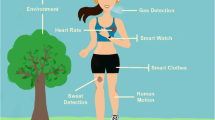Abstract
The wearable computer is a portable computer that is actually worn on the user's body. Ergonomics is therefore a vital feature of its design. Since humans naturally communicate with voice, a wearable computer also responds to the voice. Wearable computers and global wireless networks make it possible to bring exciting capabilities to the individual. Until recently, wearable computer development has been restricted to academic and military laboratories. Now, technological advances and reduced cost have ignited investor excitement about wearable computers. Wearable system applications in manufacturing, logistics, medicine, training, quality control, communications and even entertainment are now becoming widespread. The earliest development of wearable computers occurred in the 1960s. All of the elements of the modern wearable computer were in place in the Eudaemons system for predicting outcome on a roulette wheel. Since then, wearable computer development has paralleled advances in microprocessor technology. After addressing the important distinction between wearable and mobile computers, this paper will look at wearable computers as an information tool for industry. A short history of wearable computers will trace development from the early single application attempts to today's feature-rich systems. A discussion on current and anticipated applications is then followed by an overview of important related technologies. Finally, the paper will assess how wearable computers could impact twentyfirst century industry and society.
Similar content being viewed by others
References
Xybernaut Corporation. Proceedings 1998 International Conference on Wearable Computing, 1998
Bass T. The Eudaemonic pie New York: Random House 1986
Mann S. An historical account of the ‘WearComp’ and ‘WearCom’ inventions developed for applications in ‘personal imaging’. In: Digest of papers from the First International Symposium on Wearable Computers, Cambridge, Mass, 1997
Rhodes B. A brief history of wearable computing. 1998
Rehmi Post E, Reynolds M, Grey M, Paradiso J, Gershenfeld N. Intrabody buses for data and power. Digest of papers from the First International Symposium on Wearable Computers. 52–55
Siegel J, Bauer M. A field usability evaluation of a wearable system. Digest of papers from the First International Symposium on Wearable Computers, Cambridge, Mass, 1997
Ranier D, Manfred W. Mobile approach support system for future machine tools. In: Digest of papers from the First International Symposium on Wearable Computers, Cambridge, Mass, 1997
Najjar LJ, Thompson JC, Ockerman JJ. A wearable computer for quality assurance inspectors in a food processing plant. Poster presentation at First International Symposium on Wearable Computers, Cambridge, Mass, 1997
SENTEL Corporation. Wearable computer deployment and LAN communication system at United States Custom Agency Facility, Douglas, Arizona, 1997
Lind E, Jayarman S, Park S, Rajamanickam R, Eisler R, McKee T. A sensate liner for personal monitoring applications. In: Digest of papers from the First International Symposium on Wearable Computers, Cambridge, Mass, 1997
SENTEL Corporation. Proposal to Defense Advanced Research Projects Agency, BAA 97-32, Advanced Logistics Program (ALP), Sentinel Automated Material Control System
Johnston M. Xybernaut fashions wearable PC. Federal Computer Week, May 25, 1998
Mann S. ‘Smart clothing’: wearable multimedia computing and ‘personal imaging’ to restore the technological balance between people and their environments, 1998
University of Tokyo. Watch-size next-generation Information Devices. Tokyo: University of Tokyo, 1998
Author information
Authors and Affiliations
Corresponding author
Rights and permissions
About this article
Cite this article
Jackson, K.L., Polisky, L.E. Wearable computers: Information tool for the twentyfirst century. Virtual Reality 3, 147–156 (1998). https://doi.org/10.1007/BF01408557
Issue Date:
DOI: https://doi.org/10.1007/BF01408557




